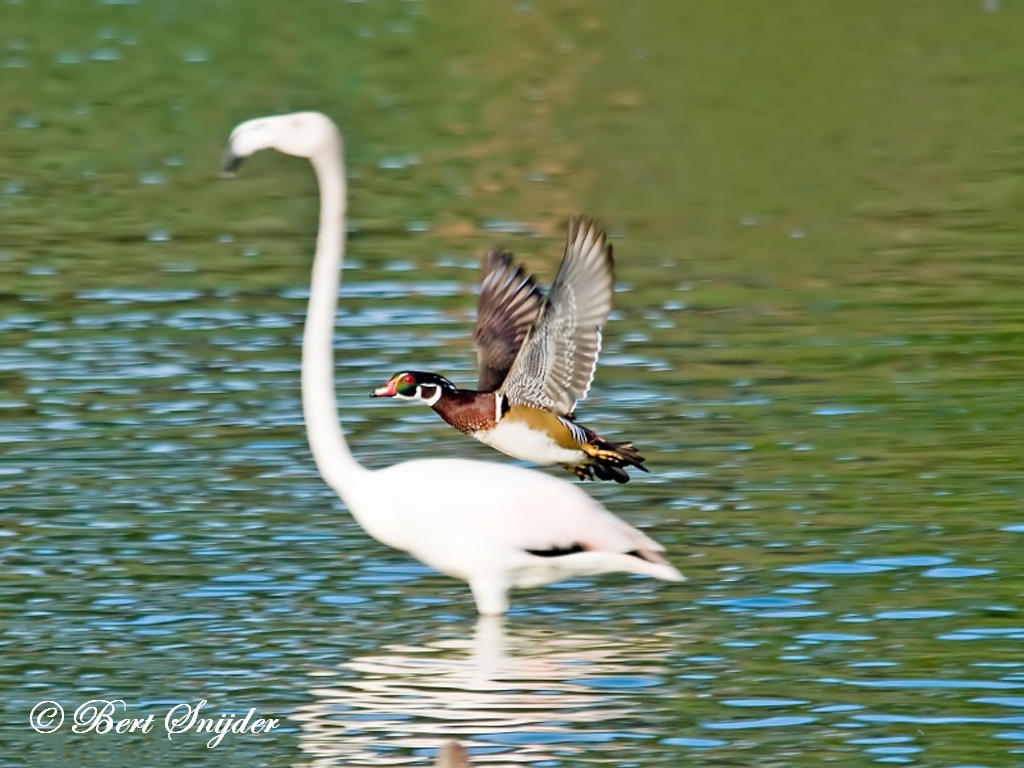Wood Duck, Carolina-eend, Brautente, Pato-carolino, Pato Joyuyo
Spotted in the Alentejo region of Portugal. Wood Duck sound
The Wood Duck is a medium-sized perching duck. A typical adult is from 47 to 54 cm (19 to 21 in) in length with a wingspan of between 66 to 73 cm (26 to 29 in). This is about three-quarters of the length of an adult Mallard. It shares its genus with the Asian Mandarin Duck (Aix galericulata).

The adult male has distinctive multicoloured iridescent plumage and red eyes,with a distinctive white flare down the neck. The female, less colourful, has a white eye-ring and a whitish throat. Both adults have crested heads.
The male’s call is a rising whistle, jeeeeee; the females utter a drawn-out, rising squeal, do weep do weep, when flushed, and a sharp cr-r-ek, cr-e-ek for an alarm call.
Their breeding habitat is wooded swamps, shallow lakes, marshes or ponds, and creeks in eastern North America, the west coast of the United States and western Mexico. They usually nest in cavities in trees close to water, although they will take advantage of nesting boxes in wetland locations if available. Females line their nests with feathers and other soft materials, and the elevation provides some protection from predators. Unlike most other ducks, the Wood Duck has sharp claws for perching in trees and can, in southern regions, produce two broods in a single season—the only North American duck that can do so.
Females typically lay between 7 and 15 white-tan eggs that incubate for an average of 30 days. However, if nesting boxes are placed too close together, females may lay eggs in the nests of their neighbours, which may lead to nests which may contain as many as 30 eggs and unsuccessful incubation, a behaviour known as “nest dumping”.
After hatching, the ducklings jump down from the nest tree and make their way to water. The mother calls them to her, but does not help them in any way. The ducklings may jump from heights of up to 88 m (290 ft) without injury. They prefer nesting over water so the young have a soft landing, but will nest up to 140 m (460 ft) away from the shoreline. The day after they hatch, the young climb to the nest entrance and jump to the ground. The ducklings can swim and find their own food by this time.
These birds feed by dabbling or walking on land. They mainly eat berries, acorns, and seeds, but also insects, making them omnivores.
The birds are year-round residents in parts of its southern range, but the northern populations migrate south for the winter. They overwinter in the southern United States near the Atlantic coast. 75% of the Wood Ducks in the Pacific Flyway are non-migratory. They are also popular, due to their attractive plumage, in waterfowl collections and as such are frequently recorded in Great Britain as escapes—populations have become temporarily established in Surrey in the past but are not considered to be self-sustaining in the fashion of the closely related Mandarin Duck. Given its native distribution the species is also a potential natural vagrant to Western Europe and there have been records in areas such as Cornwall and the Isles of Scilly which some observers consider may relate to wild birds; however, given the Wood Duck’s popularity in captivity it would be extremely difficult to prove their provenance one way or another. There is a small feral population in Dublin.
Other synonyms:
Catalan: Ànec carolí
Czech: Kachnicka karolinská, kachnièka karolinská
Welsh: Hwyaden y coed
Danish: Brudeand
German: Brautente
English: Acorn Duck, American Wood Duck, Carolina Duck, Carolina wood duck, North american wood duck, Summer Duck, Wood Duck
Spanish: Huyuyo, Pato Arcoiris, Pato de Florida, Pato de la Florida, Pato del bosque de Carolina, Pato Huyuyo, Pato Joyuyo
Spanish (Cuba): Huyuyo
Spanish (Dominican Rep.): Huyuyo
Spanish (Mexico): Pato Arcoiris
Estonian: mõrsjapart
Basque: Ahate karolinarra, Ànec carolí
Finnish: Morsiosorsa
Faroese: Brúðuront
French: Aix carolin, Canard branchu, Canard carolin, Canard des bois, Canard huppé
Irish: Lacha choille
Galician: Ànec carolí
Haitian Creole French: Kanna bwòdè
Hungarian: kisasszonyréce
Icelandic: Brúðönd
Italian: Anatra sposa
Japanese: amerikaoshi
Latin: Aix sponsa
Lithuanian: Miškine antis
Dutch: Carolinaeend, Carolina-eend
Norwegian: Brudeand
Polish: karolinka
Portuguese: Pato-carolino
Slovenian: nevestica
Swedish: Brudand
Travel Birdwatching Holiday Alentejo, Vacation Portugal for birders to see birds on your trip. Guided Birdwatching Tours & Trips.